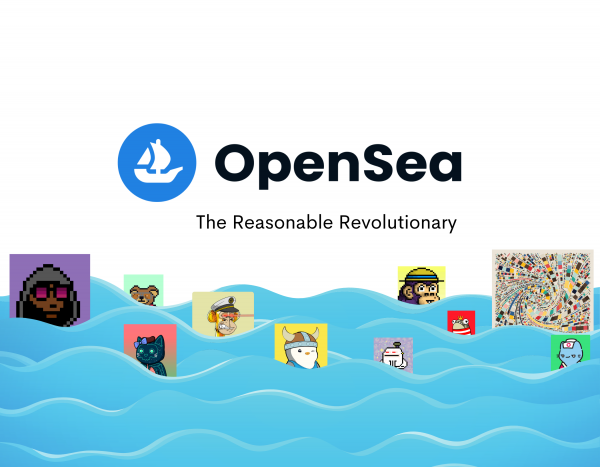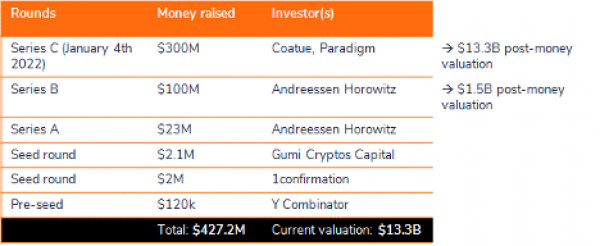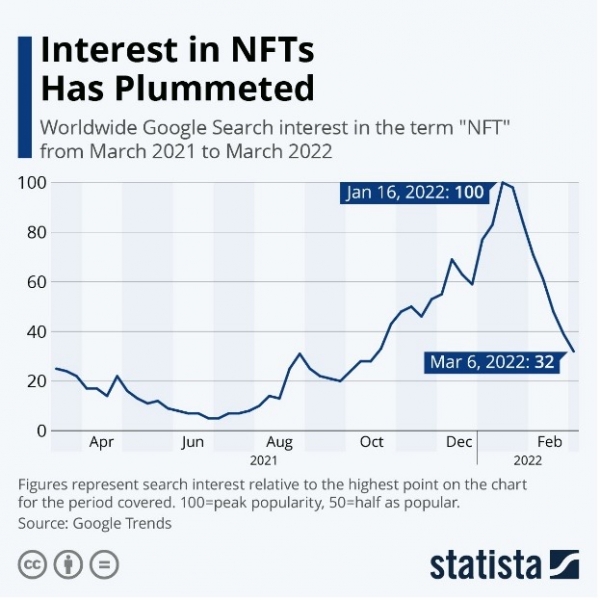Founded in 2017, OpenSea is the undisputed leader in NFTs (non-fungible tokens) exchange platforms.
As a reminder, an NFT, or non-fungible token, acts as an exclusive deed of ownership for a digital item such as a piece of art, a piece of music, an image, a video, an avatar or virtual land in a video game or even a tweet. It can be purchased at a given price, but the fact that it is non- fungible allows its market value to fluctuate over time.
OpenSea is headquartered in New York City and currently employs over 400 people. It is led by its founders, Devin Finzer and Alexander Atallah, who together have nearly 20 years of experience in technology (Google, Palantir, Apple, etc.) and crypto-assets. In 2021, OpenSea facilitated nearly $23 billion worth of transactions on its platform. This very young company sees an IPO in late 2023 or 2024.

OpenSea: modus operandi
To create an account on OpenSea, you must first have a cryptocurrency wallet accepted by the marketplace, such as MetaMask or Coinbase Wallet. Once registered, you have the option to:
- Create your NFT;
- Sell NFTs: this involves setting a price or setting up an auction. You must also choose the blockchain for your creation. OpenSea supports Ethereum (ETH), Polygon (MATIC) and Klatyn (KLAY).
- Buy NFTs: you can choose to participate in auctions or buy NFTs at a fixed price. To do this, you will need your registered cryptocurrency wallet or use a credit card. Each NFT is given a detailed page containing the characteristics or even the history of the work. Once purchased, NFTs go into the "Collected" category of your profile. Buyers use the OpenSea system for free.
Competition
At the end of December 2021, OpenSea's market share was over 65%, far ahead of its runner-up, Axie Infinity (11% market share). The rest of the market is rather fragmented with smaller players such as Rarible, Foundation, LooksRare (a newcomer), etc. Other players may soon enter the market (for instance, Coinbase is launching its own NFT marketplace).
As is the case for other exchange leaders (NYSE, Nasdaq, Coinbase, etc.), OpenSea should benefit from the network effect created by its leadership position. In other words, both buyers and sellers look for the marketplace with the highest volumes and the largest number of participants. As a result, the leader tends to reinforce its dominance over time.
In 2021, OpenSea facilitated $23.4 billion in transactions on Ethereum alone. By February 2022, the company had some 529,000 active traders (up from 274,000 and 16,000 in November 2021 and February 2021, respectively - source: Stableton), nearly doubling the number of active users every three months. Polygon-based volumes, while relatively small ($70 million in February 2022), also show strong traction.
NFTs, a “hyper growth” market
The NFT market has seen phenomenal growth in 2021, with transaction volume increasing more than 500-fold from FY 2020. According to research from NonFungible Corporation and OpenSea, the bulk of transaction volume since 2020 has been in Art (70%). The number of transactions is dominated by games and collectibles, which represent 40% and 37% respectively (source: Stableton).
The NFT market remains small and relatively concentrated for the moment. According to the Financial Times, 360,000 portfolios hold NFTs worldwide, and 9% of them represent 80% of the market in value (think of the high-profile transactions worth several million dollars that periodically make the headlines).
The capitalization of the NFT market is estimated at $710 billion for the year 2021 (source: Stableton).
OpenSea’s Revenue growth and profitability
OpenSea's business model is based on fees collected from transactions made on the platform. The seller who pays a 2.5% commission to Opensea. This means that if you sell an NFT worth 100 ETH, you keep 97.5 ETH and OpenSea keeps 2.5 ETH (2.5%).
In December alone, OpenSea recorded $2.4 billion in transactions on its marketplace, according to TechCrunch. Over the year 2021, that volume was nearly $24 billion, or roughly a 200-fold increase year-over-year. Nearly half of these transactions were completed in the last quarter.
Note that despite the crypto-currency crash seen earlier this year, the NFT market has proven resilient (see our previous analysis). January and February 2022 were the two best months on record for OpenSea.
According to many experts, the NFT market is still in its infancy and the growth potential is exponential. Most large corporations are now interested in NFTs and these tokens should benefit from the rise of the Metaverse. While OpenSea users have grown from 16,000 a year ago to over 500,000 today, these numbers are still very low compared to other trading platforms (for example, eBay has an average of 160 million active buyers).
With regards to profitability, Opensea has reached breakeven well before other crypto asset platforms such as Coinbase or Kraken and this can be explained by its relatively high transaction fees (2.5% charged to the seller).
What about future valuation?
Andreesen Horowitz was the lead investor in both the Series A and B funding rounds. The company is also backed by well-known blockchain venture capital funds such as Coinbase Ventures, Blockchain Capital, Foundation Capital, Coatue Management or Paradigm.
To date, Opensea has raised $423 million in funding. The latest "round" took place on January 4, 2022. At that time, OpenSea completed a $300 million Series C funding round, led by Paradigm and Coatue. This round brought the company's valuation to $13.3 billion. The goals of this new round is to accelerate product development, improve security and customer relations, invest in the decentralized web, and recruit. OpenSea does not mention an external growth strategy, but according to the Axios website, the marketplace is reportedly in negotiations with Dharma Labs, a cryptocurrency wallet.
Opemsea financing series

Since the January Series C, OpenSea's valuation has continued to rise. It is now estimated to be worth $16 billion.
For most investors, an IPO in late 2023/early 2024 is a distinct possibility. Assuming a doubling of revenues every year between 2021 and 2024, revenues could reach between $3.5 and $4 billion by 2024. Based on an Enterprise Value to Revenue multiple of approximately 8x to 10x (industry average), OpenSea could then claim a valuation range of between $28 and $40 billion by the end of 2024.
Limits and weaknesses
According to OpenSea, more than 80% of the NFTs created for free on the platform are plagiarized. This is a mechanism that allows users to avoid paying fees for the use of the blockchain on which the tokens are created (usually Ethereum, whose fees are relatively high), and to have them borne by the buyer of the NFTs. With this solution, fraud costs nothing to those responsible.
The figure of 80% of plagiarism seems very high and is a danger for the legitimacy and durability of the model. Faced with this observation, OpenSea first announced on January 27 that it would limit the creation of free NFT collections to 5 per user, and 50 NFTs per collection. This decision led to a wave of protests, which led OpenSea to back down. However, the platform indicated on Twitter that it was considering other solutions to counter fraudsters and protect creators.
Another challenge for OpenSea is the recent loss of momentum of NFTs. As the chart below shows, Google searches targeting NFTs have been declining sharply in recent weeks and may indicate a waning investor interest in NFTs (although it can be explained by the fact that people are now more aware of NFTs than before…).
Opensea's business model is highly dependent on NFT trading volumes and therefore on the rate of growth of the industry. Any slowdown has a direct impact on the company's valuation.
Popularity of the term "NFT" on the Google search engine

Source: Statista
Conclusion
While Opensea's revenues are growing tremendously, the New York-based company also faces many challenges. NFTs remain a relatively young and potentially highly volatile asset class. Another "crypto-winter" (sharp decline in cryptoassets) would certainly have a very significant impact on Opensea's valuation. Cyber attacks and security breaches on the platform could also damage the company's reputation and lead to an exodus of customers. Another risk related to NFTs is its uncertain regulatory landscape. For example, the status of certain digital assets is not yet well defined by the regulatory bodies (government, SEC, etc.).
Regarding the competitive aspect, OpenSea could face the arrival of many new decentralized platforms. As mentioned above, the leading crypto exchange Coinbase intends to launch its NFT exchange this year, following in the footsteps of FTX and Binance.
Despite these risks and threats, Opensea is definitely attractive to investors looking for very high potential (non- listed) companies. As mentioned above, NFTs are benefiting from several favorable winds such as the strong growth in demand but also the development of the Metaverse. In this context, Opensea could take advantage of its status as a first entrant and the famous "network effect". With over 65% market share, OpenSea has a dominant position in a market whose addressable size is currently estimated at $18 billion. OpenSea would already be profitable, and while commissions charged may decrease in the future, OpenSea's profitability could continue to increase due to the explosion in volumes. All of these elements could change quickly as this industry is evolving at a rapid pace, making any projections very hypothetical.
NB: This is not an investment recommendation
Disclaimer
This marketing document has been issued by Bank Syz Ltd. It is not intended for distribution to, publication, provision or use by individuals or legal entities that are citizens of or reside in a state, country or jurisdiction in which applicable laws and regulations prohibit its distribution, publication, provision or use. It is not directed to any person or entity to whom it would be illegal to send such marketing material. This document is intended for informational purposes only and should not be construed as an offer, solicitation or recommendation for the subscription, purchase, sale or safekeeping of any security or financial instrument or for the engagement in any other transaction, as the provision of any investment advice or service, or as a contractual document. Nothing in this document constitutes an investment, legal, tax or accounting advice or a representation that any investment or strategy is suitable or appropriate for an investor's particular and individual circumstances, nor does it constitute a personalized investment advice for any investor. This document reflects the information, opinions and comments of Bank Syz Ltd. as of the date of its publication, which are subject to change without notice. The opinions and comments of the authors in this document reflect their current views and may not coincide with those of other Syz Group entities or third parties, which may have reached different conclusions. The market valuations, terms and calculations contained herein are estimates only. The information provided comes from sources deemed reliable, but Bank Syz Ltd. does not guarantee its completeness, accuracy, reliability and actuality. Past performance gives no indication of nor guarantees current or future results. Bank Syz Ltd. accepts no liability for any loss arising from the use of this document.
Related Articles
President Donald Trump signed an executive order relating to cryptocurrencies. The US is now one step closer to the creation of a strategic bitcoin reserve. Overview below.
"There are decades where nothing happens; and there are weeks where decades happen." - Vladimir Ilyich Lenin
Solana and Ethereum are two dominant blockchains in the crypto sector, each boasting robust DeFi ecosystems and a plethora of diverse applications. The two blockchains are often seen as competitors. How do they compare?



.png)